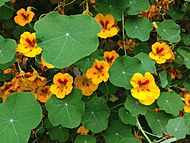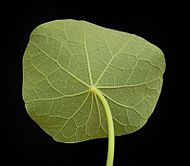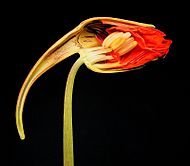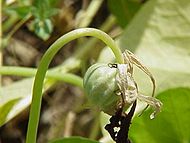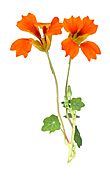Garden nasturtium facts for kids
Quick facts for kids Garden nasturtium |
|
|---|---|
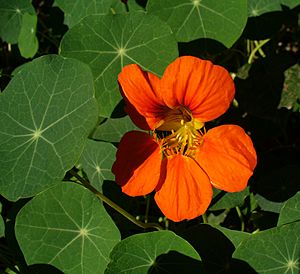 |
|
| Scientific classification | |
| Genus: |
Tropaeolum
|
| Species: |
majus
|
| Synonyms | |
|
|
The garden nasturtium (scientific name: Tropaeolum majus) is a beautiful flowering plant. It is also known as nasturtium, Indian cress, or monks cress. This plant comes from the Andes mountains in South America, from Bolivia up to Colombia.
It is an annual (grows for one year) or a short-lived perennial (grows for a few years). Nasturtiums are easy to grow and have round leaves and bright yellow, orange, or red flowers. Even though it's called "nasturtium," it's not closely related to the plant watercress, which is in the Nasturtium genus.
Contents
Understanding the Name
The garden nasturtium was first called Nasturtium indicum, meaning "Indian nasturtium." However, scientists later found it was not related to the true Nasturtium plants.
What "Tropaeolum" Means
The current name for its group, Tropaeolum, was given by Carl Linnaeus. This name means "little trophy." It comes from the Latin word tropaeum, which means "trophy."
What "Majus" Means
The second part of its scientific name, majus, is Latin for "larger." This helps tell it apart from other similar plants.
Plant Description
The garden nasturtium grows quickly. Its stems can trail along the ground, reaching about 3 to 6 feet (1 to 2 meters) long.
Nasturtium Leaves
The leaves are large and almost perfectly circular. They can be 3 to 15 centimeters (1 to 6 inches) wide. Their color ranges from green to a slightly blue-green on top, and they are lighter underneath. The leaf stalk is attached near the middle of the leaf, making it look like a shield. Several veins spread out from the center to the smooth or slightly wavy edge of the leaf.
The Lotus Effect on Leaves
Nasturtium leaves show something cool called the lotus effect. When rain falls on them, the water forms into round droplets. These droplets then roll off the leaf, taking dirt with them and leaving the leaf clean and dry. Tiny bumps of wax on the leaf surface, which can be seen with an electron microscope, help to push the water away.
Flowers and Fruit
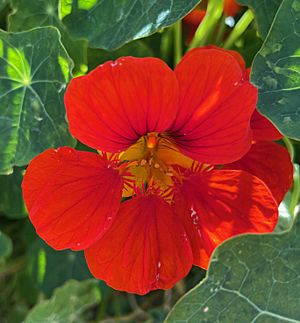
The flowers are 2.5 to 6 centimeters (1 to 2.5 inches) wide and have a light scent. Each flower has five petals and eight stamens (the parts that make pollen). At the back of the flower, there is a long tube called a nectar spur, which is about 2.5 to 3 centimeters (1 to 1.2 inches) long.
Nasturtium flowers come in many colors, including yellow, orange, and red. They often have frilly edges and darker spots near the base of the petals. After the flower, a fruit forms that is about 2 centimeters (0.8 inches) wide. This fruit has three parts, and each part holds one large seed, about 1 to 1.5 centimeters (0.4 to 0.6 inches) long.
The Flashing Flowers Phenomenon
Sometimes, especially as the sun sets, the orange nasturtium flowers might seem to give off small "flashes." This interesting event is called the Elizabeth Linnaeus Phenomenon.
People once thought this was caused by electricity. However, today we believe it's an optical trick our eyes play. It happens because of the strong contrast between the bright orange flowers and the green leaves around them. This phenomenon is named after Elisabeth Christina von Linné, the daughter of Carl Linnaeus, who first noticed it when she was 19 years old.
Nasturtium in Nature
The garden nasturtium is a food source for the young forms (called larvae or caterpillars) of some Lepidoptera species. These include the dot moth and the garden carpet moth. A common insect that likes to eat nasturtium leaves is the caterpillar of the large white or cabbage white butterfly.
Where Nasturtiums Grow Now
This plant has spread and now grows naturally in many parts of the world. You can find it in some areas of the United States, like California and New York. It also grows in parts of Europe, Asia, Africa, and Australia. In places like Hawaii and Lord Howe Island in Australia, it is considered an invasive plant. This means it can grow so well that it sometimes takes over areas where native plants used to grow.
Growing and Using Nasturtiums

Many different types of Tropaeolum majus (called cultivars) are grown in gardens. They are popular because they are easy to grow as annuals. They do best in poor, damp soil and need lots of sunshine. Their large seeds are easy for gardeners to handle.
Nasturtiums don't like heavy frost, so it's best to start them indoors in a warm place. Then, you can plant them outside after all danger of frost has passed. Since they grow quickly, you can also plant the seeds directly in the ground in May or June.
You can find nasturtium flowers in many warm colors, such as cream, yellow, orange, red, and even maroon. Some types also have very pretty patterns on their leaves. Certain groups of nasturtiums, like the Whirlybird Series and Alaska Series, have even won the Royal Horticultural Society’s Award of Garden Merit for being excellent garden plants.
Culinary Uses
Almost all parts of the nasturtium plant that grow above ground can be eaten! The flowers are often used in salads because they look so colorful and pretty. They have a slightly peppery taste, similar to watercress. You can also add them to stir-fries.
Nasturtium flowers are full of good things for you. They contain about 130 milligrams of vitamin C per 100 grams, which is about the same as parsley. They also have a lot of lutein, up to 45 milligrams per 100 grams, which is the highest amount found in any edible plant. The young, unripe seed pods can be picked and put into spiced vinegar. This makes a tasty topping or garnish, sometimes used instead of capers.
Traditional Uses
Some people in South America and Europe have used the nasturtium plant in traditional medicine. They believed it had properties that could help fight off germs and bacteria.
Gallery
See also
 In Spanish: Capuchina para niños
In Spanish: Capuchina para niños





